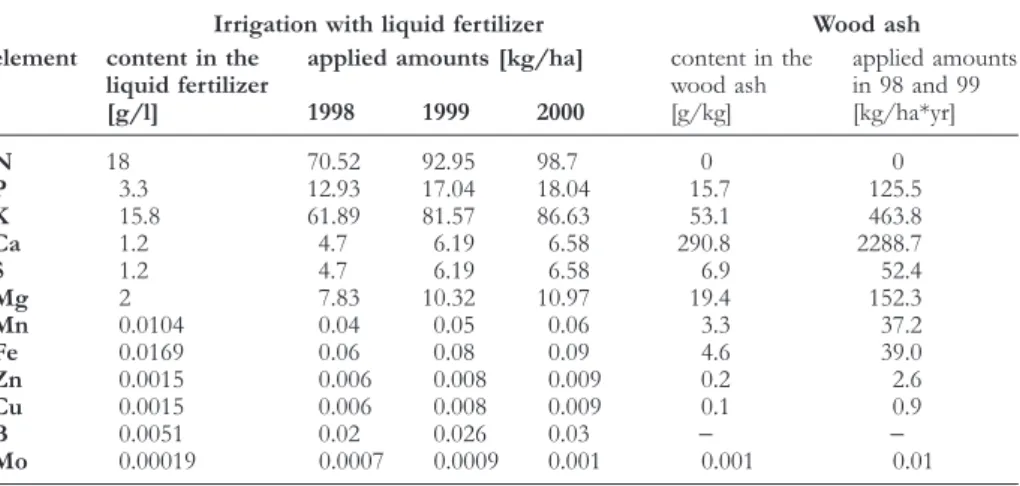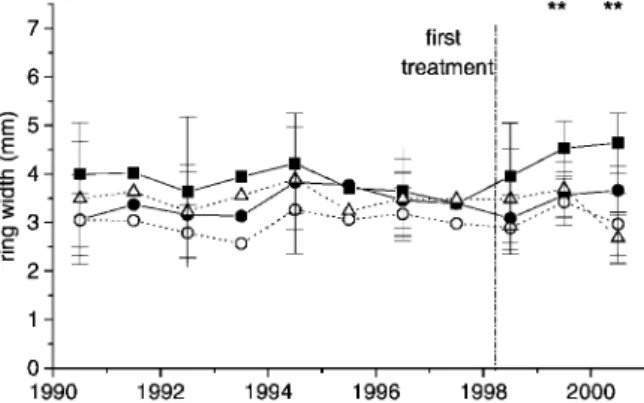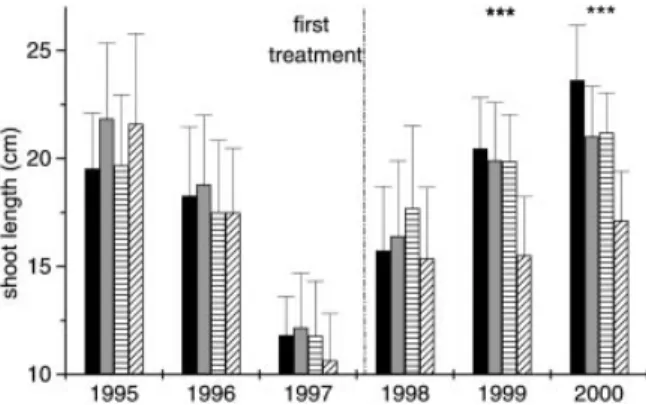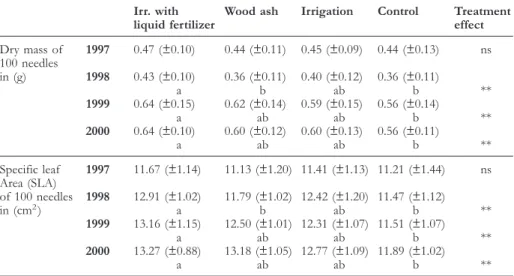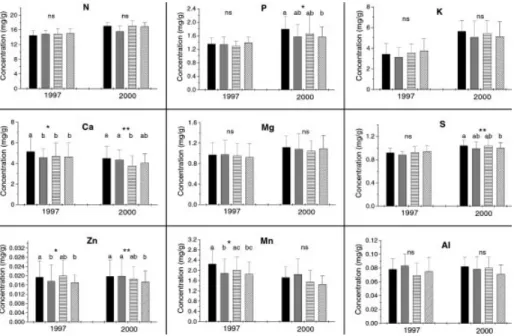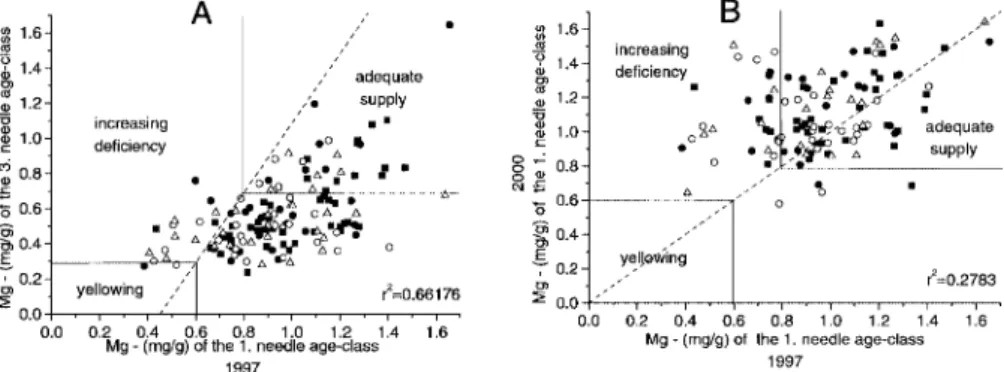Forstw. Cbl. 121 (2002), 240−249 2002, Blackwell Verlag, Berlin ISSN 0015-8003
Effects of Wood Ash and Liquid Fertilization on the
Nutritional Status and Growth of Norway Spruce
(Picea abies (L.) Karst.)
Effekte von Holzasche- und Flüssigdüngung auf die Nährstoffsituation und das Wachstum von Fichten (Picea abies (L.) Karst.)
By D. HALLENBARTER, W. LANDOLT, J.B. BUCHERand J.-P. SCHÜTZ
Summary
We examined the effects of wood ash and liquid fertilizer on the nutritional status and growth of Norway spruce (Picea abies (L.) Karst.) in a 70-year-old, managed forest in the Swiss Central Plateau. Four treatments with four replications were applied over three years during the vegetation period: treatment I⫺ irrigation with liquid fertilizer (mean: N 87, P 16, K 77 kg yr−1ha−1, with 1.5 mm/d water) with the ‘steady state fertilization’ approach; treatment II ⫺ wood ash (4000 kg yr−1 ha−1); treatment III⫺ irrigation only (1.5 mm/d); treatment IV ⫺ control. Growth was determined by analy-ses of tree rings, shoot length, needle weight and needle area. For the nutritional status, thirteen chemi-cal elements were analyzed on 136 trees.
The investigations showed increased growth of Norway spruce due to liquid-fertilization and wood ash input, but indicated no major shifts of nutrient contents and ratios in needles.
Keywords: Fertilization, forest growth, Norway spruce, wood ash
Zusammenfassung
Wir untersuchten die Effekte von Holzasche- und Flüssigdüngung im Zusammenhang mit der Nährele-mentversorgung und dem Wachstum von Fichten (Picea abies (L.) Karst.) in einem 70-jährigen Wald im Schweizer Mittelland. Vier Behandlungen wurden während 3 Jahren in der Vegetationsperiode ange-wandt: Behandlung I⫺ Flüssigdünger mit Wasser (durchschnittlich: N 87, P 16, K 77 kg a−1ha−1, unter Zugabe von 1.5 mm/d Wasser) mit Hilfe der ,steady-state-fertilization‘ Technik; Behandlung II ⫺ Holzasche (4000 kg a−1ha−1); Behandlung III⫺ Bewässerung (1.5 mm/d); Behandlung IV ⫺ Kon-trolle. Das Wachstum wurde bestimmt anhand von Jahrringanalysen, Trieblängen und Nadelgewicht und -oberfläche. Die Nährstoffsituation wurde anhand von 13 Elementen an 136 Bäumen untersucht. Auf die Holzasche- und Flüssigdüngung reagierten die Fichten mit einem erhöhten Wachstum, es gab aber keine wesentlichen Verschiebungen in den Nährstoffgehalten und -relationen.
Schlüsselwörter: Düngung, Fichte, Holzasche, Waldwachstum
1 Introduction
In the early eighties the question in different European countries arose whether forest nutrient insufficiencies or imbalances were involved in increasing crown transparencies and whether the situation could be improved by fertilization (ZÖTTL1985, HÜTTL1987).
To date, knowledge on the effects of nutrient stress on the yield, vitality and survival of forest trees in Switzerland is still too inadequate to answer these questions. Furthermore, evidence is increasing that the nutritional condition of the trees is often unsatisfactory (FLÜCKIGERand BRAUN 1995). This is mostly due to the inherently poor soil quality and
to steady nutrient loss due to continual forest management practice over the past centuries. In recent years, much efforts has been invested in several countries (BÜTTNER et al.
1998, OBERNBERGER1994) to increase the utilization of wood as an energy source in order
to reduce national net CO2-emission. This may have led to an additional export of
nutri-ents out of the forests. Hence, a sustainable use of natural resources is in great demand to achieve closed material cycles.
For these reasons, it is obviously attractive to use wood ash as a secondary raw material due to its high nutrient content since particularly in Switzerland there is an excess of wood ash (1999: 25 000 t) as a waste product from heating systems. It has been suggested that the ash from untreated wood could be returned to the forest, not primarily for waste management, but instead to recycle nutrients and to contribute to sustainable forestry.
The present study was part of a project with two primary objectives. The first was to investigate wood ash recycling in forests and its potential effects on vegetation, soil, groundwater and fauna. Secondly, we sought to establish a new type of forest nutrient optimization trial in Switzerland according to the “steady-state technique” (INGESTAD1987)
and to examine the potentials of wood ash treatment. This paper presents the results of the effects of wood ash and steady-state liquid fertilization on growth of trees; more precisely on the growth of tree rings, shoots and needles of Norway spruce (Picea abies (L.) Karst.). The hypothesis to be tested was that wood ash recycling in forests leads to increased tree growth and furthermore may improve the vitality of trees. Due to the elements available in the wood, the effects of wood ash recycling should be less pro-nounced than the optimal nutrition in the form of a steady-state liquid fertilization.
2 Materials and Methods 2.1 Study site
The study was conducted from 1997 to 2000 in a 70-year-old, managed forest of Norway spruce in association with beech, pine, ash and Douglas fir. The stand (Galio odorati-Fagetum
luzuletosum) of approx. 350 trees had undergone normal silvicultural thinning, resulting in
evenly distributed stems. The study was involved 136 Norway spruces with a mean diam-eter of 34.6 cm at breast height. The experimental site ‘Unterehrendingen’ is located in a flat area in the Swiss Central Plateau, 20 km northwest of Zurich, 450 m above sea level. The forest is situated on an acidic brown earth (Cambisol [FAO 1988]). The soil profile characteristics of the experimental site are described in BUNDTet al. (2000).
The mean annual air temperature during the three years of the experiment was 9.8°C and the relative air humidity was 78 %. Annual precipitation was 996 mm (1998), 1294 mm (1999) and 949 mm (2000). The precipitation was noticeably lower than the long-term mean during the vegetation periods in the years 1997 and 1998. Meteorological data were obtained from the official MeteoSwiss station located in Buchs-Suhr, 6 km from the study site. The yearly deposition of nitrogen and sulfur in this area is, according to an empirical model from “Meteotest”, N 34 and S 13 kg yr−1ha−1.
2.2 Treatments
The sample area was subdivided into 16 plots of about 500 m2 each. There were four
treatments with four replications, applied during the vegetation period (May⫺September) 1998⫺2000.
Treatment I⫺ irrigation with liquid fertilizer (optimal nutrition), was applied with the ‘steady-state fertilization’ approach (INGESTAD 1987). In this treatment an application of
micro- and macro-nutrient fertilizer (nutrient composition Tab. 1) was applied in small quantities with approximately 1.5 mm/d of water with sprinklers in the night during the vegetation period. The quantity of water corresponded to about one-third of the seasonal precipitation (45 mm/month).
Treatment II⫺ wood ash (nutrient composition Tab. 1) was distributed in two doses, 4000 kg ha−1in May 1998 and an equal amount again in July 1999. The wood ash was not hardened. Grate ash from the combustion of native wood generally contains low amounts of heavy metals and therefore the ash is suitable as fertilizer.
Table 1. Chemical composition (g/l) and elemental loads (kg/ha) to the forest soil by the liquid fertiliza-tion and wood ash applicafertiliza-tions.
Tabelle 1. Chemische Zusammensetzung (g/l) und eingebrachte Elementmengen (kg/ha) auf den Wald-boden durch die Flüssigdüngung und Holzascheapplikationen.
Irrigation with liquid fertilizer Wood ash element content in the applied amounts [kg/ha] content in the applied amounts
liquid fertilizer wood ash in 98 and 99
[g/l] 1998 1999 2000 [g/kg] [kg/ha*yr] N 18 70.52 92.95 98.7 0 0 P 3.3 12.93 17.04 18.04 15.7 125.5 K 15.8 61.89 81.57 86.63 53.1 463.8 Ca 1.2 4.7 6.19 6.58 290.8 2288.7 S 1.2 4.7 6.19 6.58 6.9 52.4 Mg 2 7.83 10.32 10.97 19.4 152.3 Mn 0.0104 0.04 0.05 0.06 3.3 37.2 Fe 0.0169 0.06 0.08 0.09 4.6 39.0 Zn 0.0015 0.006 0.008 0.009 0.2 2.6 Cu 0.0015 0.006 0.008 0.009 0.1 0.9 B 0.0051 0.02 0.026 0.03 − − Mo 0.00019 0.0007 0.0009 0.001 0.001 0.01
Treatment III ⫺ the irrigation treatment, was identical to treatment I but without fertilizer supplement.
Treatment IV⫺ was the control with no additional application to the plots.
2.3 Analyses of tree-ring width
In February 2001, 60 dominant trees from the center of the treatment plots were selected from the 136 sample trees (categories according to KRAFT 1) and two perpendicular cores were taken at breast height. Core sample preparation followed PILCHER(1990). The
tree-ring widths were measured to 0.01 mm using the linear table Lintab (Rinn S.A., Heidelberg, Germany) and the Time Series Analysis and Presentation program TSAP (RINN1996). Cross-dating and correction for missing rings were conducted according to
the established dendrochronological principle of BRÄKER (1981). We used the procedure
implemented in the TSAP-program (synchronism values and STUDENT’s t-test) and
com-bined the single curves into tree mean-curves and site chronologies.
2.4 Shoot length
Terminal shoot growth was measured on 136 dominant and co-dominant trees (categories according to KRAFT 1 and 2). Shoots were taken from the upper third of the sun-exposed crowns in 1997 and 2001. In each case, the terminal shoots of the latest three years were measured in order to obtain time series of six years. The accuracy of the measurements was ± 1 mm.
2.5 Needle weight, area and nutritional status
Needles of three age classes (1, 2, 3 years old) from the uppermost crown were taken yearly in December or January. The samples were dried at 65°C for 48 hours. The 100-needle weight and area were measured for the one-year-old 100-needles. The specific leaf area (SLA) was measured using the “WinNeedle” Program from Re´gent Instruments INC.
The contents of N and total C were determined using a C+N analyzer (NA⫺ 1500 from CE⫺ Instruments) and for the concentrations of Al, B, Ca, Cu, Fe, K, Mg, Mn, P,
S and Zn an inductive coupled plasma atomic emission spectrometer (Optima 3000 from Perkin⫺ Elmer) was used.
2.6 Data analyses
Statistical analysis was performed using SAS software (SAS version 6.12, SAS Institute Inc.). For each measurement and each sampling date, the analysis of variance (ANOVA) was tested for the effects of the treatments on the units shoot length, needle weight and area and nutritional status. Prior to ANOVA the null hypothesis for the homogeneity of each error variance was tested by the SHAPIRO-WILKprocedure.
Treatment effects on time series of tree-rings were analyzed as repeated measurement ANOVA. The variable year (within-factor) and the four treatments (between-factors) were tested. The SCHEFFEtest was applied for multiple dependent comparisons.
3 Results 3.1 Analyses of tree-rings
Figure 1 presents the ring width chronology for the ten years 1990⫺2000. Liquid fertilizer, wood ash and irrigation were applied for the first time in May 1998. In the following year the ring widths under the liquid fertilized treatment increased significantly. There was an increase of 30 percent in the three experimental years compared with the control, while wood ash and irrigation treatments did not significantly increase ring width. Despite this effect of fertilization, ring widths on the fertilized plots were still within the variation of the last decade, where the mean annual increment of all trees was 3.53 mm.
Fig. 1. Ring width at breast height (mean ± sd). Significant differences between treatments were tested with a repeated measures ANOVA. *p < 0.05; **p < 0.01; ***p < 0.001. Significant differences resulted only between irrigation with liquid fertilizer and control. (䊏) irrigation with liquid fertilizer, (䊉) wood ash, (䊊) irrigation, (䉭) control.
Abb. 1. Jahrringbreite auf Brusthöhe (Mittelwert ± Standardabweichung). Unterschiede zwischen den Behandlungen wurden getestet mit einer „repeated measures ANOVA“. *p < 0.05; **p < 0.01; ***p < 0.001. Signifikante Unterschiede ergaben nur Flüssigdünger zur Kontrolle. (䊏) Bew. mit Flüssig-dünger (䊉) Holzasche, (䊊) Bewässerung, (䉭) Kontrolle.
3.2 Shoot length
In winter 1994/95 the sample area was thinned out. The lower competition for light and nutrients due to this thinning produced increased shoot growth in 1995. In the following two years, shoot growth decreased due to unfavorable weather conditions. In 1998 shoot lengths increased again independent of the treatments which began in spring of the same year (Fig. 2).
Fig. 2. Shoot length (mean ± se). Differences between treatments were tested with an ANOVA. *p < 0.05; **p < 0.01; ***p < 0.001. Significant differences resulted only between irrigation with liquid fertilizer and control.䊏Irrigation with liquid fertilizer;䊏wood ash;䊐⫺ irrigation; 䊐//control. Abb. 2. Trieblänge (Mittelwert ± Standardabweichung). Unterschiede zwischen den Behandlungen wur-den mit einer ANOVA getestet. *p < 0.05; **p < 0.01; ***p < 0.001. Signifikante Unterschiede ergaben nur Flüssigdünger zur Kontrolle.䊏 Bew. mit Flüssigdünger;䊏Holzasche;䊐⫺ Bewässerung; 䊐// Kon-trolle.
One year later, mean shoot length was significantly enhanced by up to 25 percent under the liquid fertilizer treatment. Irrigation as well as wood ash also increased shoot growth, but to a lesser extent.
3.3 Needle weight and area
The data of the overall mean 100-needle weight and specific leaf area (SLA), shown in Tab. 2, agree well with data reported by FLOWER-ELLIS(1993) and ROBERNTZ(1999). Needle
weight and SLA responded to fertilization and irrigation more quickly than shoot growth. Even after one year, significant increases under liquid fertilizer treatment could be meas-ured. Wood ash treatment produced a markedly slower response than the other treatments. The effect of stand thinning in 1994/95 was less pronounced in specific leaf area and 100-needle weight than in shoot growth.
3.4 Nutritional status of needles
Figure 3 shows the element contents in relation to differences between the treatments. There were only slight differences in 1997 and 2000 between the treatments. Moreover, differences between the sample plots already existed before the first treatment in 1998. In 2000, the element contents were higher in most cases, independent of the treatments. According to various nutrient tables (HÜTTL1991, ZÖTTL 1992), all trees were already
optimally or sufficiently supplied with most elements at the beginning of the investigation. Only the values of manganese were higher from the target value. Manganese (and partly iron) contents were elevated under all treatments and in all years and the contents in-creased with increasing needle age. The maximum value (6455 µg g−1 dry mass) was measured in a liquid fertilizer treatment in three-year-old needles in 2000. Similarly high values have also been found in other investigations under similar acidic soil conditions (BLOCKet al. 1991).
For a reliable assessment of the nutritional situation, several needle ages should be considered. This is necessary because trees are able to meet the nutritional requirements of the young needles at the expense of the older needles in a deficiency situation (RIEK
and WOLFF1998). Unfortunately, confirmed data about element contents in the different
mag-Table 2. 100-needle dry weight (g) and specific leaf area (SLA) of 100 needles (cm2
) in the different treatments (mean ± sd) from 1997 to 2000. In rows, means followed by the same letter are not significantly different (p < 0.05). Significant differences between treatments (ANOVA) are shown in the right column. *p < 0.05; **p < 0.01; ***p < 0.001; ns not significant.
Tabelle 2. 100-Nadel Gewicht (g) und die spezifische Oberfläche (specific leaf area⫺ SLA) von 100 Nadeln (cm2) bei den verschiedenen Behandlungen (Mittelwert ± Standardabweichung) in den Jahren 1997⫺2000. Horizontal: Mittelwerte mit gleichen Buchstaben unterschieden sich nicht signifikant (p < 0.05). Signifikante Unterschiede zwischen den Behandlungen (ANOVA) werden in der letzten Spalte gezeigt, *p < 0.05; **p < 0.01; ***p < 0.001; ns nicht signifikant.
Irr. with Wood ash Irrigation Control Treatment
liquid fertilizer effect
Dry mass of 1997 0.47 (±0.10) 0.44 (±0.11) 0.45 (±0.09) 0.44 (±0.13) ns 100 needles in (g) 1998 0.43 (±0.10) 0.36 (±0.11) 0.40 (±0.12) 0.36 (±0.11) a b ab b ** 1999 0.64 (±0.15) 0.62 (±0.14) 0.59 (±0.15) 0.56 (±0.14) a ab ab b ** 2000 0.64 (±0.10) 0.60 (±0.12) 0.60 (±0.13) 0.56 (±0.11) a ab ab b ** Specific leaf 1997 11.67 (±1.14) 11.13 (±1.20) 11.41 (±1.13) 11.21 (±1.44) ns Area (SLA) of 100 needles 1998 12.91 (±1.02) 11.79 (±1.02) 12.42 (±1.20) 11.47 (±1.12) in (cm2) a b ab b ** 1999 13.16 (±1.15) 12.50 (±1.01) 12.31 (±1.07) 11.51 (±1.07) a ab ab b ** 2000 13.27 (±0.88) 13.18 (±1.05) 12.77 (±1.09) 11.89 (±1.02) a ab ab b **
nesium contents was provided by REEMTSMA(1986). In this system the magnesium supply
is split up into three steps (Tab. 3). Figure 4 shows the contents of magnesium before and after the treatments. Graph A shows the 1st and 3rd needle age class prior to the first treatment (1997). Only a few trees were in the potentially yellowing range. Around 20 % of the trees were already adequately supplied with magnesium at the beginning of the treatments, whereas 80 % fell in the range of ‘increasing deficiency’. Graph B shows the relation between the 1st needle age classes of the years 1997 and 2000. Only 25 % of all trees were not adequately supplied. This example shows that investigations of the nutritional status of only the youngest needle age class tend to produce disproportionately positive findings.
Relations between the different elements are often used for the estimation of the nutritional status of trees. In Tab. 4 our data are shown in comparison with reference values according to HÜTTL(1991). Except for potassium in 1997, all elements were below
the limits which would point to an over-supply of nitrogen. For potassium the relationship to N was significantly improved under the treatments with liquid fertilizer. Thus, a disturb-ance of the nutrient level by the increased nitrogen deposition is not likely. There were no substantial differences in nutrient contents of the needles between treatments, and fluctuations between years were greater than those between the treatments.
4 Discussion 4.1 Tree growth
Growth increased under all treatments and the control during the experiment (Fig. 2, Table 2). Three factors may be primarily responsible for this observation: thinning during winter 1994/95, the storm “Lothar” in 1999, which knocked down 21 trees (9 % of the
Fig. 3. Element contents (mg g−1dry mass) of first year needles of the uppermost crown of Norway spruce in 1997 and 2000. Plotted are means (± sd) of 36 trees per treatment. Needles were collected in 1997 before the first treatment. Significant differences between treatments (ANOVA) are shown above the histograms. *p < 0.05; **p < 0.01; ***p < 0.001; ns not significant. Treatments with the same letters are not significantly different. 䊏 Irrigation with liquid fertilizer; 䊏wood ash; 䊐⫺ irrigation; 䊐//control.
Abb. 3. Elementgehalte (mg g−1TS) in einjährigen Fichtennadeln des obersten Kronendrittels in den Jahren 1997 und 2000. Dargestellt sind die Mittelwerte (± Standardabweichung) von je 36 Fichten pro Behandlung. Die Nadeln aus dem Jahre 1997 wurden vor der ersten Behandlung gesammelt. Signifikante Unterschiede zwischen den Behandlungen (ANOVA) werden oberhalb der Balken dargestellt, *p < 0.05; **p < 0.01; ***p < 0.001; ns nicht signifikant. Behandlungen mit gleichen Buchstaben unter-schieden sich nicht signifikant (p < 0.05).䊏 Bew. mit Flüssigdünger;䊏Holzasche; 䊐⫺ Bewässerung; 䊐//Kontrolle.
Table 3. Three steps of the magnesium supply according to REEMTSMA(1986) and ZÖTTL(1990). Tabelle 3. Drei Stufen der Magnesiumversorgung nach REEMTSMA(1986) and ZÖTTL(1990). “adequate Mg-supply” Mg-content in the 1st needle age class > 0.8 mg/g.
In the 3rd needle age class > 0.9 mg/g.
Reduction in the 3rd needle age class to 0.7 mg/g through aging. “increasing deficiency” Sharp decline between 1st and 3rd needle age class. Mg-contents in
the 3rd needle age class > 0.3 mg/g.
“deficiency, undershooting of Mg-content in the 1st needle age class < 0.6 mg/g. the yellowing threshold” In the 3rd needle age class < 0.3 mg/g.
trees in the study area), considerably reducing competition for light and nutrients, and additionally the dry weather conditions during the vegetation periods of 1997 and 1998. Similar relationships between dry and wet conditions and tree growth are reported by ELLING(1990).
Fig. 4. Comparison of Mg-contents in needles of Norway spruce (n = 142). A: 1st and 3rd needle age class of the harvest 1997. B: 1st needle age classes of the harvests 1997 and 2000. Dashed line: comparison section. According to the evaluations of REEMTSMA(1986), ZÖTTL(1990) and RIEKand WOLFF(1998). (䊏) Irrigation with liquid fertilizer, (䊉) wood ash, (䊊) irrigation, (䉭) control. Abb. 4. Gegenüberstellung der Mg-Gehalte von Fichtennadeln (n = 142). A: 1. und 3. Nadeljahrgang der Ernte 1997. B: die 1. Nadeljahrgänge der Ernten 1997 und 2000, nach den Bewertungsgrenzen Von REEMTSMA(1986), ZÖTTL(1990) und RIEKund WOLFF(1998). Gestrichelte Linie: Schnittlinie der Gegenüberstellung. (䊏) Bew. mit Flüssigdünger, (䊉) Holzasche, (䊊) Bewässerung, (䉭) Kontrolle. Table 4. Element relations in the years 1997 and 2000 of the youngest needle age classes in different treatments: (IL) irrigation with liquid fertilizer, (WA) wood ash, (I) irrigation, (C) control. (n = 34 trees per treatment).
Tabelle 4. Elementrelationen in den Jahren 1997 und 2000 der jüngsten Nadeljahrgänge in den Behand-lungen: (IL) Bew. mit Flüssigdünger, (WA) Holzasche, (I) Wasser, (C) Kontrolle. (n = 34 Fichten pro Behandlung).
Element Critical limit for 1997 2000
N saturation1) P IL N/P > 12 10.9 9.2 WA 10.8 9.9 I 11.1 10.6 C 10.8 10.7 K IL N/K > 3 4.3 2.9 WA 4.1 2.8 I 4.0 3.2 C 4.5 3.6 Ca IL N/CA > 20 2.7 3.7 WA 3.3 3.9 I 3.3 4.6 C 3.3 4.4 Mg IL N/MG > 30 14.1 15.4 WA 15.9 14.7 I 16.6 15.9 C 16.4 15.2 1)according to H ÜTTL(1991) 4.2 Nutritional status
The addition of liquid fertilizer did not lead to major changes in nutrient contents or relations, but did increase growth parameters (SCHRÖCK1996) which are important for the
trans-parency can be understood as an indicator for the availability of nutrients. Acidic soils with low nutrient supply do not necessarily imply an unbalanced nutrient status, but may negatively influence forest health.
Over the past fifty years, nitrogen loads due to deposition have increased significantly in the forests of the Swiss Central Plateau. However, the consequences of such an nitrogen impact may differ from site to site. On the one hand, it may reduce N-deficiency in soils where a shortage predominates. On the other hand, according to various investigations, increased nitrogen depositions are critical for element balance in soils where a sufficient N-supply already exists (FLÜCKIGERet al. 1997). Average N deposition on this site was
estimated at 34 kg N ha−1yr−1, but the absence of differences between the results of the treatments precludes any conclusions.
The study confirmed the well known annual fluctuation of nutrient concentrations in needles. In this context, weather conditions such as rainfall or drought periods (SAUTER
1991) are an important modifying parameter. In this work, the youngest needle age classes showed lower contents of most elements and also less balanced element ratios in dry years, particularly in the year 1998.
5 Conclusions
Different approaches for assessing the nutrient status of trees may lead to different con-clusions, depending on which needle age classes are compared. The optimal nutrition approach used in the present study has the advantage that tree response itself is used as a guideline for judging the nutrient level of the plants.
For the experimental site Unterehrendingen, no essential changes, neither in a single nutrient nor in nutrient ratios, were observed. Variation in the element concentrations from year to year exceeded the differences between treatments. It may be concluded therefore, that the trees studied are well supplied in terms of contents as well as ratios between the elements.
Wood ash recycling acts primarily as a soil conditioner and not as a fertilizer, whereas steady-state fertilization may be seen as a helpful tool for detecting and ameliorating nutritional imbalances. If tree nutrition is sufficient and no major changes appear, as was the case in this study, optimal nutrition increases growth and may decrease crown trans-parency.
6 Acknowledgements
The wood ash and nutrient optimization experiment was established with the support and permission of the forest administration of Baden and the local forest owners. This work is part of the COST Project E6 “forest tree physiology” and was additionally supported by the Swiss Federal Office for Education and Science (BBW) and the Swiss Agency for the Environment, Forests and Landscape (BUWAL). Many thanks are also due to P. BLEULER, U. BÜHLMANN and P. SUTTERfor their skillful technical help in the field, and
to M.S. SIEBERfor editing the English.
7 References
BLOCK, J., BOPP, O., GATTI, M., HEIDINGSFELD, N., ZOTH, R., 1991: Waldschäden, Nähr- und Schadstoffge-halte in Nadeln und Waldböden in Rheinland-Pfalz. Mitteilungen aus der Forstlichen Versuchsanstalt Rheinland-Pfalz. Nr. 17, 170 pp.
BRÄKER, O.U., 1981: Der Alterstrend bei Jahrringdichten und Jahrringbreiten von Nadelhölzern und sein Ausgleich. Mitt. Forstl. Bundes-Vers.anst. Wien 142, 75⫺102.
BUNDT, M., ALBRECHT, A., FROIDEVAUX, P., BLASER, P., FLÜHLER, H., 2000: Impact of preferential flow on radionuclide distribution in soil. Environ. Sci. Technol. 34, 3895⫺3899.
BÜTTNER, G., GERING, C., NELL, U., RUMPF, S., WILPERT, V.K., 1998: Einsatz von Holzasche in Wäldern. Forst und Holz 53, 72⫺76.
ELLING, W., 1990: Schädigungsverlauf und Schädigungsgrad von Hochlagen-Fichtenbeständen in Nord-ostbayern. Allg. Forstzeitschrift 45, 74⫺77.
FAO, 1988: FAO-UNESCO soil map of the world. 60. Food and Agricultural Organisation of the United Nations, Rome.
FLOWER-ELLIS, J.G.K., 1993: Dry-matter allocation in Norway spruce branches: a demographic approach. In: LINDER, S., KELLOMÄKI, S. (eds.), Management of Structure and Productivity of Boreal and Subalp-ine Forests. Studia Forestalia Suecica 191, 94 pp.
FLÜCKIGER, W., BRAUN, S., 1995: Revitalization of an alpine protective forest by fertilization. Plant and Soil. 168, 481⫺488.
FLÜCKIGER, W., BRAUN, S., QUIRING, R., 1997: Wieviel Stickstoff ertragen unsere Wälder? Untersuchungen über Wirkungszusammenhänge. In: Säure- und Stickstoffbelastungen⫺ ein Risiko für den Schweizer Wald? Forum für Wissen, WSL. 59−72.
HÜTTL, R.F., 1987: „Neuartige“ Waldschäden, Ernährungsstörungen und Düngung. Allg. Forst Zeitung, 12, 289-297.
HÜTTL, R.F., 1991: Nährelementversorgung geschädigter Wälder in Europa und Nordamerika. Habil. Schrift. Freiburger Bodenkundl. Abh. 28, 440 pp.
INGESTAD, T., 1987: New concepts on soil fertility and plant nutrition as illustrated by research on forest trees and stands. Geoderma 40, 237⫺252.
OBERNBERGER, I., 1994: Sekundärrohstoff Holzasche. Tagungsband. Institut für Verfahrenstechnik, TU Graz. 149 pp.
PILCHER, J.R., 1990: Sample preparation, cross-dating and measurement. In: COOK, E.R., KAIRIUKSTIS, L.A. (eds.), Methods of Dendrochronology. Applications in the Environmental Sciences. Kluwer Academic, Dordrecht, 40⫺51.
REEMTSMA, J.B., 1986: Der Magnesiummangel von Nadeln Niedersächsischer Fichtenbestände und seine Beurteilung. Allg. Forst- und Jagdz. 157, 196⫺203.
RIEK, W., WOLFF, B., 1998: Verbreitung von Nährstoffmangel bei Waldbäumen in Deutschland. Ergeb-nisse der Nadel-/Blattanalysen im Rahmen der BZE. AFZ/Der Wald 10.
RINN, F., 1996: TSAP-Reference manual. Frank Rinn, Heidelberg.
ROBERNTZ, P., 1999: Effects of long-term CO2 enrichment and nutrient availability in Norway spruce. I. Phenology and morphology of branches. Trees 13, 188⫺198.
SAUTER, U., 1991: Zeitliche Variation des Ernährungszustands nordbayerischer Kiefernbestände. Forstw. Cbl. 110, 13⫺33.
SCHRÖCK, 1996: Untersuchungen an Waldökosystem-Dauerbeobachtungsflächen in Rheinland-Pfalz. Mitteilungen aus der Forstlichen Versuchsanstalt Rheinland-Pfalz. Nr. 40/97.
ZÖTTL, H.W., 1985: Waldschäden und Nährelementversorgung. Düsseldorfer Geobot. Kolloq., 2, 31⫺41.
ZÖTTL, H.W., 1990: Ernährung und Düngung der Fichte. Forstwiss. Cbl. 109, 130⫺137.
ZÖTTL, H.W., 1992: Die Blattanalyse als Diagnose- und Monitoringinstrument in Waldökosystemen. Freiburger Bodenkundliche Abhandlungen, Heft 30, 59 S.
Authors’ address: D. HALLENBARTER, W. LANDOLT, J.B. BUCHER, WSL Swiss Federal Research Institute, Zürcherstrasse 111, 8903 Birmensdorf, Switzerland; J.-P. SCHÜTZ, Swiss Federal Insti-tute of Technology, Department of Forest and Wood Sciences, ETH, 8092 Zurich, Switzerland.
